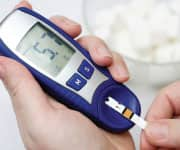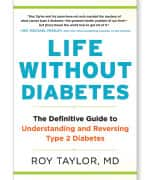Life Extension Magazine®

Type 2 diabetes is a devastating condition that is associated with serious complications like heart disease, blindness, kidney failure, lower-limb amputations, cancer, and more.
Generally, it has been considered an irreversible, progressive disease.
Research by Dr. Roy Taylor, an expert on diabetes, and author of more than 300 scientific papers, asserts a workable strategy for type 2 diabetes is found in something Life Extension® has been promoting for years: calorie restriction.
After treating people with type 2 diabetes for four decades, Dr. Taylor launched his own important research on the prevention and reversal of type 2 diabetes.
In his new book, Life Without Diabetes: The Definitive Guide to Understanding and Reversing Type 2 Diabetes, Dr. Taylor explains the exciting results. He also outlines a surprisingly simple and effective plan that has helped thousands of diabetics to improve their metabolic status.
In this interview with Life Extension® Dr. Taylor discusses the key research that led him to these discoveries.
—Laurie Mathena
LE: A few years ago, you had an insight that showed you diabetes could be reversed in certain individuals. Can you tell us more about that?
Dr. Taylor: For centuries, doctors have regarded type 2 diabetes as a lifelong disease. It is a disease that can cause great misery—threats to eyesight, to limbs, to the heart—and one that just gets worse and worse, needing more and more tablets and eventually, insulin.
Reading scientific journals and keeping up with the latest information about diabetes is part of my job, and I had just turned over a page in one of the leading diabetes publications. The graph hit me between the eyes.
It showed what happened to blood sugar in the days immediately after bariatric surgery in people with type 2 diabetes. The graph line plunged from the usual high level on the day before surgery all the way down to absolutely normal by day seven.
Normal blood sugar levels? In seven days?
That had never been seen before. No other treatment could achieve this dramatic normalization. All the research of the previous few decades seemed to come together in a flash.

LE: You ended up conducting a series of studies that showed that diabetes was reversible in a certain population—but also showed how and why. It all started with what you call the Twin Cycle Hypothesis. Can you explain that?
Dr. Taylor: Ask someone what type 2 diabetes is and they are likely to tell you that the disease is something to do with too much sugar.
It is true that diabetes occurs when there is excess glucose in the bloodstream—with devastating effects on the eyes, feet, heart and brain.
In the normal functioning of the body, the pancreas produces insulin to help the liver [and cells throughout the body] control the supply of glucose to the rest of the body.
When there is excess fat in the liver, however, it responds poorly to insulin, produces too much glucose, and passes on excess fat to the pancreas. As a result of that, the insulin-producing cells of the pancreas cease to function properly.
Once established, these two vicious cycles will interact and reinforce each other. Too much fat from the liver will drive the pancreas cycle, and high glucose levels will eventually force up the insulin levels, driving the liver cycle.
LE: How did you use calorie restriction to test this hypothesis?
Dr. Taylor: The chase was on to find out whether the Twin Cycle Hypothesis was wrong—or right. We would do this by asking people with type 2 diabetes to lose a lot of weight. This meant that a sudden drop in food intake would be the only change, with no other complicating factors such as surgery.
If their blood glucose stayed high, we would have shown the hypothesis to be wrong and we could go back to the drawing board. If their blood glucose normalized, type 2 diabetes would have been shown to be reversible.
LE: Enter the Counterpoint study.
Dr. Taylor: In a working life of testing hypotheses, nothing had paved the way for the starkly clear results of the Counterpoint study.
A group of people with very ordinary type 2 diabetes switched to a low-calorie diet, a simple liquid formula diet with non-starchy vegetables that I designed merely as a tool to find out if the twin cycles could be reversed.
Within seven days, their levels of early-morning blood glucose had dropped to normal—just like after bariatric surgery. Special tests on liver and pancreas confirmed what the hypothesis had predicted—the fat levels inside these organs decreased.
We had shown that in people who had been diagnosed with type 2 diabetes no more than four years previously, the imagined twin cycles within the liver and pancreas could be reversed.
LE: As the next step, you conducted a follow-up study called Counterbalance to see if blood glucose levels could continue to be controlled after the period of rapid weight loss.
Dr. Taylor: In Counterbalance, rapid weight loss was first achieved in eight weeks using exactly the same diet as Counterpoint; and then we reintroduced normal foods in a stepwise fashion over two weeks.
Over the following six months, our research participants kept their average weight rock steady. At the end of this, everyone who had got rid of their diabetes after the initial weight loss remained non-diabetic.
Just like in Counterpoint, the pancreas woke up after weight loss and started to produce insulin normally again, this time for nine months after the start of the study.
Important for understanding how this happened, liver fat remained really low, at 2%, and their pancreas fat fell to even safer levels.

LE: Have you seen these results in the real world as well?
Dr. Taylor: When the newspapers, radio, and TV reported on the results of Counterpoint, those affected by type 2 diabetes were extremely enthusiastic; they really wanted to find out for themselves whether or not they could escape from the disease.
We received a huge number of emails from people asking how they could reverse their own diabetes. To cope, we set up a website containing all the practical information and explaining what they could do to try to improve their condition.
A second wave of emails then told amazing stories of individuals who had achieved normal blood sugar levels. Young and old, men and women, rich and poor, living in India, the U.S., South America, Europe, or elsewhere—there was a rich variety of personal stories.
The average weight loss achieved by people armed with the basic information was the same as in Counterpoint—33 pounds.
LE: In your study, you used a liquid diet to achieve rapid weight loss. Could calorie restriction be utilized instead?
Dr. Taylor: If you can’t bear the idea of going on liquid formula drinks for several weeks with or without vegetables, you can of course use ordinary foods. You would have to make up meals containing around 200 calories, with no more than 800 calories a day.
LE: Why is rapid weight loss so important?
Dr. Taylor: In the first week of a 700-800 calorie diet, the average weight loss is eight pounds. During the whole eight weeks it is just over 33 pounds.
This might sound rather alarming: is it healthy to cut back so much on eating?
But the hard evidence is that for anyone who has increased their weight during adult life, or has always been overweight, losing the extra weight and then eating less long-term is of huge benefit to health. In our overfed society, fasting is not usually dangerous, but eating is.
You don’t have to lose weight fast to reverse your diabetes, but for most people it’s the easiest way of losing the requisite number of pounds.
LE: Does the length of time a person has had diabetes make a difference in being able to successfully reverse it?
Dr. Taylor: Yes. The longer the duration of type 2 diabetes, the lower the likelihood was of getting back to normal glucose control.
The important message is that it’s never too late to attempt to reverse your diabetes, although success is not guaranteed.
Editor’s Note: For years Life Extension® has educated customers about the dangers of elevated blood sugar and the importance of diet. The use of supplements and/or medications is a major factor in the prevention of the damage that elevated blood sugar levels has on tissues, including blood vessels and nerves. For additional information please visit www.lifeextension.com/diabetes to read our Diabetes and Glucose Control protocol.
If you have any questions on the scientific content of this article, please call a Life Extension® Wellness Specialist at 1-866-864-3027.
About the Author: Dr. Roy Taylor has been treating people with type 2 diabetes for four decades. He is director of the Magnetic Resonance Centre and an honorary and consultant physician at Newcastle upon Tyne Hospitals NHS Foundation Trust. He is the author of over 300 scientific papers.

Excerpted from Life Without Diabetes by Roy Taylor,
reprinted with permission from HarperOne an imprint of HarperCollins Publishers, © 2020.
To order a copy of Life Without Diabetes, call 1-800-544-4440 or visit www.LifeExtension.com.

